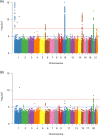Low-frequency variation near common germline susceptibility loci are associated with risk of Ewing sarcoma
- PMID: 32881892
- PMCID: PMC7470401
- DOI: 10.1371/journal.pone.0237792
Low-frequency variation near common germline susceptibility loci are associated with risk of Ewing sarcoma
Abstract
Background: Ewing sarcoma (EwS) is a rare, aggressive solid tumor of childhood, adolescence and young adulthood associated with pathognomonic EWSR1-ETS fusion oncoproteins altering transcriptional regulation. Genome-wide association studies (GWAS) have identified 6 common germline susceptibility loci but have not investigated low-frequency inherited variants with minor allele frequencies below 5% due to limited genotyped cases of this rare tumor.
Methods: We investigated the contribution of rare and low-frequency variation to EwS susceptibility in the largest EwS genome-wide association study to date (733 EwS cases and 1,346 unaffected controls of European ancestry).
Results: We identified two low-frequency variants, rs112837127 and rs2296730, on chromosome 20 that were associated with EwS risk (OR = 0.186 and 2.038, respectively; P-value < 5×10-8) and located near previously reported common susceptibility loci. After adjusting for the most associated common variant at the locus, only rs112837127 remained a statistically significant independent signal (OR = 0.200, P-value = 5.84×10-8).
Conclusions: These findings suggest rare variation residing on common haplotypes are important contributors to EwS risk.
Impact: Motivate future targeted sequencing studies for a comprehensive evaluation of low-frequency and rare variation around common EwS susceptibility loci.
Conflict of interest statement
The authors have read the journal's policy and the authors of this manuscript have the following competing interests: Leidos Biomedical Research Inc. and Information Management Services, Inc. provided salaries for authors J.M., E.K., C.L.D., L.B., K.J., M.M., K.W., and W.Z. This does not alter our adherence to PLOS ONE policies on sharing data and materials. There are no patents, products in development or marketed products to declare.
Figures


References
-
- Jawad MU, Cheung MC, Min ES, Schneiderbauer MM, Koniaris LG, Scully SP. Ewing sarcoma demonstrates racial disparities in incidence-related and sex-related differences in outcome: an analysis of 1631 cases from the SEER database, 1973–2005. Cancer. 2009;115: 3526–3536. 10.1002/cncr.24388 - DOI - PubMed
Publication types
MeSH terms
Grants and funding
LinkOut - more resources
Full Text Sources

